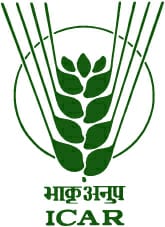New Varieties
Pulses Varieties Developed by ICAR-Indian Institute of Pulses Research, Kanpur
1: Chickpea variety IPC 2010-142 (Kuber)
| SL | Title | Desi Chickpea Variety: IPC 2010-142 (Kuber) (Year of Release: 2022 – SVRC) |
|---|---|---|
| 1 (a) | Name of Division | Division of Crop Improvement |
| (b) | Name of the Institute | ICAR-Indian Institute of Pulses Research, Kanpur 208 024 |
| 2 | Title of the research & technology developed during the last five years | Desi Chickpea Variety IPC 2010-142 (Kuber) |
| 3 | Salient feature of the Research/Technology | This variety was released in 2022 (Gazette notification No. 1056 (E) dated 06.03.2023. It is resistant to Fusarium wilt and moderately resistant to dry root rot, Ascochyta blight and BGM diseases. It has large seed size (29.1g/100 seed weight) with brown seed colour. It matures in 130-140 days with yield of 20-22q/ha. It has semi-erect growth habit with medium tall (60.0 cm). It is suitable for the cultivation under timely sown condition in Western and Eastern region of Uttar Pradesh |
| 4 | Developed by (Name / Designation / Contact No./Email ld) | Dr.Yogesh Kumar, Principal Scientist & Chickpea Breeder
Mob.: 9430139411; Mail:yogesh.kumar8@icar.gov.in; dryogeshtiwari70@gmail.com |
| 5 | How this technology contributed to agricultural advancements of improved farmers practices | Adoption of the high yielding variety will increase the yield and production of the farmers leading to increased income and livelihood security. |
2: Chickpea variety IPCK 2009-145 (Kanchan)
| SL | Title | Kabuli Chickpea Variety: IPCK 2009-145 (Kanchan) (Year of Release: 2022 – SVRC) |
|---|---|---|
| 1 (a) | Name of Division | Division of Crop Improvement |
| (b) | Name of the Institute | ICAR-Indian Institute of Pulses Research, Kanpur 208 024 |
| 2 | Title of the research & technology developed during the last five years | Desi Chickpea Variety IPC 2009-145 (Kanchan) |
| 3 | Salient feature of the Research/Technology | This variety was released in 2022 (Gazette notification No. 1056 (E) dated 06.03.2023. It is moderately resistant to wiltdisease. It has large seed size (32.2g/100 seed weight) with seed creamy white colour. It matures in 130-135 days with yield of 18-20 q/ha and suitable for timely sown condition in Western and Central region of Uttar Pradesh |
| 4 | Developed by (Name / Designation / Contact No./Email ld) | Dr.Yogesh Kumar, Principal Scientist & Chickpea Breeder
Mob.: 9430139411; Mail:yogesh.kumar8@icar.gov.in; dryogeshtiwari70@gmail.com |
| 5 | How this technology contributed to agricultural advancements of improved farmers practices | Adoption of the high yielding variety will increase the yield and production of the farmers leading to increased income and livelihood security. |
3: Chickpea variety IPCK 2013-163 (Madhav)
| SL | Title | Kabuli Chickpea Variety: IPCK 2013-163 (Madhav)(Year of Release: 2021 – CVRC) |
|---|---|---|
| 1 (a) | Name of Division | Division of Crop Improvement |
| (b) | Name of the Institute | ICAR-Indian Institute of Pulses Research, Kanpur 208 024 |
| 2 | Title of the research & technology developed during the last five years | Desi Chickpea Variety IPC 2013-163 (Madhav) |
| 3 | Salient feature of the Research/Technology | This variety was released in 2021 (Gazette notification No. 8 (A) dated 24.12.2021. It is resistant to wiltdisease with large seed size (28.7g/100 seed weight) with creamy beige seed. It matures in 125-135 days with yield of 22-24 q/ha and suitable for the cultivation under timely sown condition in North Western Plan Zone (NWPZ) of India including Punjab, Haryana, North Rajasthan, Delhi, Western Uttar Pradesh |
| 4 | Developed by (Name / Designation / Contact No./Email ld) | Dr.Yogesh Kumar, Principal Scientist & Chickpea Breeder
Mob.: 9430139411; Mail:yogesh.kumar8@icar.gov.in; dryogeshtiwari70@gmail.com |
| 5 | How this technology contributed to agricultural advancements of improved farmers practices | Adoption of the high yielding variety will increase the yield and production of the farmers leading to increased income and livelihood security. |
4: Chickpea variety IPC 2007-28 (Atal)
| SL | Title | Desi Chickpea Variety: IPC 2007-28 (Atal)(Year of Release: 2021 – SVRC) |
|---|---|---|
| 1 (a) | Name of Division | Division of Crop Improvement |
| (b) | Name of the Institute | ICAR-Indian Institute of Pulses Research, Kanpur 208 024 |
| 2 | Title of the research & technology developed during the last five years | Desi Chickpea Variety IPC 2007-28 (Atal) |
| 3 | Salient feature of the Research/Technology | This chickpea variety was released in 2021 (Gazette notification No. 8 (A) dated 24.12.2021. It is highly resistant to Fusarium wilt disease and tolerant to collar rot diseases with brown seed colour and medium seed size (18.5g/100 seed wt.). It matures in 115-125 days with yield of 20-22 q/ha and suitable for late sown condition in Eastern region of Uttar Pradesh |
| 4 | Developed by (Name / Designation / Contact No./Email ld) | Dr.Yogesh Kumar, Principal Scientist & Chickpea Breeder
Mob.: 9430139411; Mail:yogesh.kumar8@icar.gov.in; dryogeshtiwari70@gmail.com |
| 5 | How this technology contributed to agricultural advancements of improved farmers practices | Adoption of the high yielding variety will increase the yield and production of the farmers leading to increased income and livelihood security. |
5: Chickpea variety IPC 2010-134 (Shiva)
| SL | Title | Desi Chickpea Variety: IPC 2010-134 (Shiva)(Year of Release: 2021 – SVRC) |
|---|---|---|
| 1 (a) | Name of Division | Division of Crop Improvement |
| (b) | Name of the Institute | ICAR-Indian Institute of Pulses Research, Kanpur 208 024 |
| 2 | Title of the research & technology developed during the last five years | Desi Chickpea Variety IPC 2010-134 (Shiva) |
| 3 | Salient feature of the Research/Technology | This chickpea variety was released in 2021 (Gazette notification No. 8 (A) dated 24.12.2021. It is highly resistant to Fusarium wilt and moderately tolerant to dry root rot diseases with brown seed colour and large seed size (23.0g/100 seed wt.). It matures in 125-135 days with the yield of 22-24q/ha and suitable for timely sown condition in Western and Bundelkhand region of Uttar Pradesh |
| 4 | Developed by (Name / Designation / Contact No./Email ld) | Dr. Yogesh Kumar, Principal Scientist & Chickpea Breeder
Mob.: 9430139411; Mail:yogesh.kumar8@icar.gov.in; dryogeshtiwari70@gmail.com |
| 5 | How this technology contributed to agricultural advancements of improved farmers practices | Adoption of the high yielding variety will increase the yield and production of the farmers leading to increased income and livelihood security. |
6: Chickpea variety IPC 2011-112 (Keshav)
| SL | Title | Desi Chickpea Variety: IPC 2011-112 (Keshav) (Year of Release: 2020 – SVRC) |
|---|---|---|
| 1 (a) | Name of Division | Division of Crop Improvement |
| (b) | Name of the Institute | ICAR-Indian Institute of Pulses Research, Kanpur 208 024 |
| 2 | Title of the research & technology developed during the last five years | Desi Chickpea Variety IPC 2011-112 (Keshav) |
| 3 | Salient feature of the Research/Technology | This chickpea variety was released in 2020 (Gazette notification No. 3099 (E) dated 07.10.2020. It is resistant to Fusarium wilt diseases with brown seed colour and medium seed size (22.0g/100 seed wt.). It matures in 120-125 days with the yield of 22-25 q/ha and suitable for the cultivation under timely sown condition in Western and Eastern region of Uttar Pradesh. |
| 4 | Developed by (Name / Designation / Contact No./Email ld) | Dr. SK Chaturvedi, Principal Scientist & Chickpea Breeder
Mob.: 9336214977; Mail: sushilk.chaturvedi@gmail.com |
| 5 | How this technology contributed to agricultural advancements of improved farmers practices | Adoption of the high yielding variety will increase the yield and production of the farmers leading to increased income and livelihood security. |
7: Chickpea variety IPC 2005-62 (High Protein)
| SL | Title | Desi Chickpea Variety: IPC 2005-62 (High Protein)(Year of Release: 2020 – SVRC) |
|---|---|---|
| 1 (a) | Name of Division | Division of Crop Improvement |
| (b) | Name of the Institute | ICAR-Indian Institute of Pulses Research, Kanpur 208 024 |
| 2 | Title of the research & technology developed during the last five years | Desi Chickpea Variety IPC 2005-62 (High Protein) |
| 3 | Salient feature of the Research/Technology | This chickpea variety was released in 2020 (Gazette notification No. 99 (E) dated 06.01.2020. It has higher seed protein content (>26.47%) with resistant to wiltdisease. It has light brown seed colour and small seed size (15.2g/100 seed wt.). It matures in 120-125 days with the yield of 18-20 q/ha and suitable for the cultivation under late sown condition in Western and Bundelkhand region of Uttar Pradesh |
| 4 | Developed by (Name / Designation / Contact No./Email ld) | Dr. SK Chaturvedi, Principal Scientist & Chickpea Breeder
Mob.: 9336214977; Mail: sushilk.chaturvedi@gmail.com |
| 5 | How this technology contributed to agricultural advancements of improved farmers practices | Adoption of the high yielding variety will increase the yield and production of the farmers leading to increased income and livelihood security. |
8: Chickpea variety IPC 2004-98
| SL | Title | Desi Chickpea Variety: IPC 2004-98 (Year of Release: 2020 – SVRC) |
|---|---|---|
| 1 (a) | Name of Division | Division of Crop Improvement |
| (b) | Name of the Institute | ICAR-Indian Institute of Pulses Research, Kanpur 208 024 |
| 2 | Title of the research & technology developed during the last five years | Desi Chickpea Variety IPC 2004-98 |
| 3 | Salient feature of the Research/Technology | This chickpea variety was released in 2020 (Gazette notification No. 99 (E) dated 06.01.2020. It is resistant to wiltdisease with brown seed colour and large seed size (25.8g/100 seed wt.). It matures in 135-140 days with the yield of 18-20 q/ha and suitable for the cultivation under timely sown condition in Central and Bundelkhand region of Uttar Pradesh |
| 4 | Developed by (Name / Designation / Contact No./Email ld) | Dr. SK Chaturvedi, Principal Scientist & Chickpea Breeder
Mob.: 9336214977; Mail: sushilk.chaturvedi@gmail.com |
| 5 | How this technology contributed to agricultural advancements of improved farmers practices | Adoption of the high yielding variety will increase the yield and production of the farmers leading to increased income and livelihood security. |
9: Desi Chickpea Variety: IPC 2004-01
| SL | Title | Desi Chickpea Variety: IPC 2004-01 (Year of Release: 2020 – SVRC) |
|---|---|---|
| 1 (a) | Name of Division | Division of Crop Improvement |
| (b) | Name of the Institute | ICAR-Indian Institute of Pulses Research, Kanpur 208 024 |
| 2 | Title of the research & technology developed during the last five years | Desi Chickpea Variety IPC 2004-01 |
| 3 | Salient feature of the Research/Technology | This chickpea variety was released in 2020 (Gazette notification No. 3482 (E) dated 07.10.2020. It is resistant to wiltdisease with brown seed colour and medium seed size (20.0g/100 seed wt.). It matures in 135-140 days with the yield of 18-20 q/ha and suitable for the cultivation under timely sown condition in Central and Bundelkhand region of Uttar Pradesh |
| 4 | Developed by (Name / Designation / Contact No./Email ld) | Dr. SK Chaturvedi, Principal Scientist & Chickpea Breeder
Mob.: 9336214977; Mail: sushilk.chaturvedi@gmail.com |
| 5 | How this technology contributed to agricultural advancements of improved farmers practices | Adoption of the high yielding variety will increase the yield and production of the farmers leading to increased income and livelihood security. |
10: Desi Chickpea Variety: IPC 2006-77
| SL | Title | Desi Chickpea Variety: IPC 2006-77 (Year of Release: 2019 – CVRC) |
|---|---|---|
| 1 (a) | Name of Division | Division of Crop Improvement |
| (b) | Name of the Institute | ICAR-Indian Institute of Pulses Research, Kanpur 208 024 |
| 2 | Title of the research & technology developed during the last five years | Desi Chickpea Variety IPC 2006-77 |
| 3 | Salient feature of the Research/Technology | This chickpea variety was released in 2019 (Gazette notification No. 3220 (E) dated 06.09.2019. It is resistant to wiltand moderately resistant to dry root rot, stunt, collar rot diseases. It has light brown seed colour with medium seed size (16.5g/100 seed wt.) snd higher seed protein (>24%). It matures in 115-120 days with the yield of 20-22 q/ha and suitable for the cultivation under late sown condition in Central Zone of India comprising with Madhya Pradesh, Maharashtra, Gujarat, South Rajasthan, and Bundelkhand Region of Uttar Pradesh. |
| 4 | Developed by (Name / Designation / Contact No./Email ld) | Dr. SK Chaturvedi, Principal Scientist & Chickpea Breeder
Mob.: 9336214977; Mail: sushilk.chaturvedi@gmail.com |
| 5 | How this technology contributed to agricultural advancements of improved farmers practices | Adoption of the high yielding variety will increase the yield and production of the farmers leading to increased income and livelihood security. |
11: Urdbean variety: IPU11-02
| SL | Title | Urdbean variety: IPU11-02 (Year of Release: 2019- SVRC) |
|---|---|---|
| 1 (a) | Name of Division | Division of Crop Improvement |
| (b) | Name of the Institute | ICAR-Indian Institute of Pulses Research, Kanpur 208 024 |
| 2 | Title of the research & technology developed during the last five years | Urdbean variety: IPU11-02 |
| 3 | Salient feature of the Research/Technology | This variety was released in 2019. Potential Yield: 10-12 q/ha, Duration: 80-85 days, Recommended Areas: Madhya Pradesh and Uttar Pradesh, Special Characters: Dull black colour with medium large seed (4.3g/100 seed wt.) and high protein content (26%), resistant to MYMV, ULCV, PM, anthracnose and Cercospora leaf spot. It is suitable for the cultivation under timely sown condition in Uttar Pradesh and Madhya Pradesh for Kharifseason. |
| 4 | Developed by (Name / Designation / Contact No./Email ld) | Dr. P. K. Katiyar, Principal Scientist, and Head, Crop Improvement Division
Mob.: 7985162116; Mail:iiprseed@gmail.com |
| 5 | How this technology contributed to agricultural advancements of improved farmers practices | Adoption of the high yielding variety will increase the yield and production of the farmers leading to increased income and livelihood security. |
| 6 | Details of impact on farmers livelihood and agricultural practices | This variety received 42.95 q indent for 2023-24. This variety becoming very popular among urdbean growers in UP and MP. |
12: Urdbean variety: IPU13-1
| SL | Title | Urdbean variety: IPU13-1 (Year of Release: 2020- SVRC) |
|---|---|---|
| 1 (a) | Name of Division | Division of Crop Improvement |
| (b) | Name of the Institute | ICAR-Indian Institute of Pulses Research, Kanpur 208 024 |
| 2 | Title of the research & technology developed during the last five years | Urdbean variety: IPU13-1 |
| 3 | Salient feature of the Research/Technology | This variety was released in 2020. Potential Yield: 10-12 q/haDuration: 70-75 days, Recommended Areas: Madhya Pradesh and Uttar Pradesh, Special Characters: Dull black seed colour, medium large seed (4.14g/100 seed wt.) with high protein content (26%), resistant to MYMV, Cercospora leaf spots, ULCV, stem necrosis, web blight, BLB, anthracnose, Powdery Mildew. |
| 4 | Developed by (Name / Designation / Contact No./Email ld) | Dr. P. K. Katiyar, Principal Scientist Mob.: 7985162116; Mail:iiprseed@gmail.com |
| 5 | How this technology contributed to agricultural advancements of improved farmers practices | Adoption of the high yielding variety will increase the yield and production of the farmers leading to increased income and livelihood security. |
| 6 | Details of impact on farmers livelihood and agricultural practices | This variety received 78.48 qindent for 2023-24. This variety becoming very popular among urdbean growers in UP and MP. |
13:Urdbean variety: IPU10-26
| SL | Title | Urdbean variety: IPU10-26 (Year of Release: 2020- SVRC) |
|---|---|---|
| 1 (a) | Name of Division | Division of Crop Improvement |
| (b) | Name of the Institute | ICAR-Indian Institute of Pulses Research, Kanpur 208 024 |
| 2 | Title of the research & technology developed during the last five years | Urdbean variety: IPU10-26 |
| 3 | Salient feature of the Research/Technology | This variety was released in 2020. Potential Yield: 10-12 q/ha
Duration: 70-75 days, Recommended Areas: Madhya Pradesh, Special Characters: Shining black seed colour, medium large seed (3.82g/100 seed wt.) with high protein content (25%), highly resistant to MYMV, Cercospora leaf spot and resistant to ULCV, stem necrosis, web blight, BLB, anthracnose, Powdery Mildew. |
| 4 | Developed by (Name / Designation / Contact No./Email ld) | Dr. P. K. Katiyar, Principal Scientist Mob.: 7985162116; Mail:iiprseed@gmail.com |
| 5 | How this technology contributed to agricultural advancements of improved farmers practices | Adoption of the high yielding variety will increase the yield and production of the farmers leading to increased income and livelihood security. |
| 6 | Details of impact on farmers livelihood and agricultural practices | This variety received 47.60 qindent for 2023-24. This variety becoming very popular among urdbean growers in MP. |
14:Urdbean variety: IPU 17-1
| SL | Title | Urdbean variety: IPU 17-1(Year of Release: 2021- SVRC) |
|---|---|---|
| 1 (a) | Name of Division | Division of Crop Improvement |
| (b) | Name of the Institute | ICAR-Indian Institute of Pulses Research, Kanpur 208 024 |
| 2 | Title of the research & technology developed during the last five years | Urdbean variety: IPU17-1 |
| 3 | Salient feature of the Research/Technology | This variety was released in 2021. Potential Yield: 10-12 q/ha
Duration: 70-77 days, Recommended Areas: Madhya Pradesh Special Characters: early maturity , Attractive black seed colour, medium large seeds (3.35 g/100 seeds) with high protein content (24.16 %), good for dal and highly palatable, resistant to MYMV, Cercospora leaf spots, ULCV, stem necrosis, web blight, BLB, anthracnose, Powdery Mildew. |
| 4 | Developed by (Name / Designation / Contact No./Email ld) | Dr.DebjyotiSen Gupta, Senior Scientist, Plant Breeding, Mob.: 8918422931; Mail:debjyoti.gupta@icar.gov.in |
| 5 | How this technology contributed to agricultural advancements of improved farmers practices | Adoption of the high yielding variety will increase the yield and production of the farmers leading to increased income and livelihood security. |
| 6 | Details of impact on farmers livelihood and agricultural practices | This variety received 11.35 qindent for 2023-24. This variety becoming very popular among urdbean growers in MP. |
15: Mungbean variety: IPM302-2
| SL | Title | Mungbean variety: IPM302-2 (Year of Release: 2018- SVRC) |
|---|---|---|
| 1 (a) | Name of Division | Division of Crop Improvement |
| (b) | Name of the Institute | ICAR-Indian Institute of Pulses Research, Kanpur 208 024 |
| 2 | Title of the research & technology developed during the last five years | Mungbean variety: IPM 302-2 (Kanika) |
| 3 | Salient feature of the Research/Technology | The widely adaptable variety, IPM 302-2 (Kanika), developed from the cross PM 4/EC 398897 has also be released and notified for Uttar Pradesh state for cultivation during Kharif season. This variety outperformed the best check IPM 02-3 by showing yield superiority of 27% over best check IPM 02-3. Having a yield potential of 11-12 q/ha, this variety is highly resistant to yellow mosaic disease, has large attractive green and shining seeds and is suitable; for both Kharif and Spring.
|
| 4 | Developed by (Name / Designation / Contact No./Email ld) | Dr.AdityaPratap, Principal Scientist, and PC, Kharif Pulses; Mob.: 8318242160; Mail:Aditya.Pratap@icar.gov.in
|
| 5 | How this technology contributed to agricultural advancements of improved farmers practices | Adoption of the high yielding variety will increase the yield and production of the farmers leading to increased income and livelihood security. |
16: Mungbean variety: IPM 2K14-9 (Varsha)
| SL | Title | Mungbean variety: IPM 2K14-9 (Varsha) (Year of Release: 2018- SVRC) |
|---|---|---|
| 1 (a) | Name of Division | Division of Crop Improvement |
| (b) | Name of the Institute | ICAR-Indian Institute of Pulses Research, Kanpur 208 024 |
| 2 | Title of the research & technology developed during the last five years | Mungbean variety: IPM 2K14-9 (Varsha) |
| 3 | Salient feature of the Research/Technology | This variety has been developed following pedigree method of breeding from the cross EC 998885/PDM 139. It was tested in UP state Adaptive Trials during kharif season for 3 years (2014-16) and it outperformed the best check variety IPM 02-3 showing a yield superiority of >35% and has been released and notified for Kharif cultivation in Uttar Pradesh. With a yield potential of 10-12 q/ha., this variety matures in 65-75 days. It is highly resistant to all major diseases of mungbean.
|
| 4 | Developed by (Name / Designation / Contact No./Email ld) | Dr.AdityaPratap, Principal Scientist, and PC, Kharif Pulses; Mob.: 8318242160; Mail:Aditya.Pratap@icar.gov.in
|
| 5 | How this technology contributed to agricultural advancements of improved farmers practices | Adoption of the high yielding variety will increase the yield and production of the farmers leading to increased income and livelihood security. |
17: Mungbean variety: IPM 312-20 (Vasudha)
| SL | Title | Mungbean variety: IPM 312-20 (Vasudha)(Year of Release: 2020- SVRC) |
|---|---|---|
| 1(a) | Name of Division | Division of Crop Improvement |
| (b) | Name of the Institute | ICAR-Indian Institute of Pulses Research, Kanpur 208 024 |
| 2 | Title of the research & technology developed during the last five years | Mungbean variety: IPM 312-20 (Vasudha)
|
| 3 | Salient feature of the Research/Technology | Developed from the cross IPM 03-1/SPS 5, with an average yield potential of 10-11 q/ha, this variety is highly resistant to yellow mosaic and resistant to Cercospora leaf spot and powdery mildew diseases and has green, shining, attractive and medium large (3.9 g/100 seed) seeds. It matures in 70-80 days. This variety has been recommended for cultivation during Spring season in Uttar Pradesh.
|
| 4 | Developed by (Name / Designation / Contact No./Email ld) | Dr.AdityaPratap, Principal Scientist, and PC, Kharif Pulses; Mob.: 8318242160; Mail:Aditya.Pratap@icar.gov.in
|
| 5 | How this technology contributed to agricultural advancements of improved farmers practices | Adoption of the high yielding variety will increase the yield and production of the farmers leading to increased income and livelihood security. |
18: Mungbean variety: IPM 512-1 (Soorya)
| SL | Title | Mungbean variety: IPM 512-1 (Soorya) (Year of Release: 2020- CVRC) |
|---|---|---|
| 1 (a) | Name of Division | Division of Crop Improvement |
| (b) | Name of the Institute | ICAR-Indian Institute of Pulses Research, Kanpur 208 024 |
| 2 | Title of the research & technology developed during the last five years | Mungbean variety: IPM 512-1 (Soorya) |
| 3 | Salient feature of the Research/Technology | This variety has been developed from the cross IPM 99-125/Co 5 and was released and notified for cultivation in North East Plain Zone for spring season. IPM 512-1, exhibited an average yield potential of 1255 kg/ha. This variety is highly resistant to Mungbean Yellow Mosaic disease and anthracnose and moderately resistant to Cercospora leaf spot. It has green, shining, attractive and medium-large seeds (3.9g/100 seed) with 21.53 % protein content.
|
| 4 | Developed by (Name / Designation / Contact No./Email ld) | Dr. Aditya Pratap, Principal Scientist, and PC, Kharif Pulses; Mob.: 8318242160; Mail:Aditya.Pratap@icar.gov.in
|
| 5 | How this technology contributed to agricultural advancements of improved farmers practices | Adoption of the high yielding variety will increase the yield and production of the farmers leading to increased income and livelihood security. |
19: Mungbean variety: IPM 409-4 (Heera)
| SL | Title | Mungbean variety: IPM 409-4 (Heera) (Year of Release: 2020- SVRC) |
|---|---|---|
| 1 (a) | Name of Division | Division of Crop Improvement |
| (b) | Name of the Institute | ICAR-Indian Institute of Pulses Research, Kanpur 208 024 |
| 2 | Title of the research & technology developed during the last five years | Mungbean variety: IPM 409-4 (Heera) |
| 3 | Salient feature of the Research/Technology | This variety, popularly named as Heera, was developed from the cross PDM 288/IPM 03-1 and recommended for Spring cultivation in Uttar Pradesh in 2020. This variety has an average yield of 10-12 q/ha with a potential of up to 15 q/ha and matures in 65-75 days. It has green, medium large (3.5g/100 seed) and shining seeds. This variety has been recommended for cultivation during Spring season in Uttar Pradesh. It is highly resistant to yellow mosaic disease, powdery mildew and Cercospora leaf spot.
|
| 4 | Developed by (Name / Designation / Contact No./Email ld) | Dr.AdityaPratap, Principal Scientist, and PC, Kharif Pulses; Mob.: 8318242160; Mail:Aditya.Pratap@icar.gov.in
|
| 5 | How this technology contributed to agricultural advancements of improved farmers practices | Adoption of the high yielding variety will increase the yield and production of the farmers leading to increased income and livelihood security. |
20: Fieldpea variety: IPF 16-13 (Harit)
| S.N. | Title | Fieldpea variety: IPF 16-13 (Harit) |
|---|---|---|
| 1(a) | Name of Division: | Crop Improvement Division |
| (b) | Name of Institute: | ICAR-IIPR, Kanpur |
| 2 | Title of the Research & Technologies developed during the last five years: | IPF 16-13 (Harit) |
| 3 | Salient feature of the Research/Technology: | Tall, green seeded and leafy type variety. It has average grain yield of 1752 kg/ha across different locations of NEPZ. Moreover, it is resistant to powdery mildew and moderately tolerant to rust disease. It is released and notified for North Eastern Plain Zone comprised of Bihar, Assam, Chhattisgarh, West Bengal and eastern part of Uttar Pradesh. |
| 4 | Developed by (Name/Designation/Contact No./Email ld): | Dr. AK Parihar, Senior Scientist, 7376301342, ashok.parihar@icar.gov.in |
| 5 | How this technology contributed to agricultural advancements or improved farmer practices: | Adoption of the high yielding variety will increase the yield and production of the farmers leading to increased income and livelihood security. |
| 6 | Details of Impact on farmer’s livelihood and agricultural practices: | This variety got 137.4qt indent of breeder seed in last three years. |
21: Fieldpea variety:IPFD 12-8 (Aakash)
| S.N. | Title | Fieldpea variety:IPFD 12-8 (Aakash) |
|---|---|---|
| 1(a) | Name of Division: | Crop Improvement Division |
| (b) | Name of Institute: | ICAR-IIPR, Kanpur |
| 2 | Title of the Research & Technologies developed during the last five years: | IPFD 12-8 (Aakash)
|
| 3 | Salient feature of the Research/Technology: | This variety is white, dwarf and leafy type. It has yield potential upto 25 qt/ha. In addition, it is resistant to powdery mildew and rust disease. It has medium seed size with round, smooth and white colour and yellow cotyledon. It is released & notified for whole Uttar Pradesh. |
| 4 | Developed by (Name/Designation/Contact No./Email ld): | Dr. AK Parihar, Senior Scientist, 7376301342, ashok.parihar@icar.gov.in |
| 5 | How this technology contributed to agricultural advancements or improved farmer practices: | Adoption of the high yielding variety will increase the yield and production of the farmers leading to increased income and livelihood security. |
| 6 | Details of Impact on farmer’s livelihood and agricultural practices: | The breeder seed indent of this variety has been increased from 9.0 to 20.0 qt during last three years. |
22: Fieldpea variety:IPFD 13-2 (Anant)
| S.N. | Title | Fieldpea variety: IPFD 13-2 (Anant) |
|---|---|---|
| 1(a) | Name of Division: | Crop Improvement Division |
| (b) | Name of Institute: | ICAR-IIPR, Kanpur |
| 2 | Title of the Research & Technologies developed during the last five years: | IPFD 13-2 (Anant) |
| 3 | Salient feature of the Research/Technology: | The average grain yield of variety is 17-18qt/ha across different locations of Uttar Pradesh. It is resistant to powdery &downey mildew and rust disease. It has medium seed size with round, smooth and white colour and yellow cotyledon. Hence, it is released & notified for whole Uttar Pradesh. |
| 4 | Developed by (Name/Designation/Contact No./Email ld): | Dr. AK Parihar, Senior Scientist, 7376301342, ashok.parihar@icar.gov.in |
| 5 | How this technology contributed to agricultural advancements or improved farmer practices: | Adoption of the high yielding variety will increase the yield and production of the farmers leading to increased income and livelihood security. |
| 6 | Details of Impact on farmer’s livelihood and agricultural practices: | The breeder seed indent of this variety has been increased from 5.0 to 34.0 qt during last three years. |
23: Fieldpea variety:Central Field pea IPFD 2014-2
| S.N. | Title | Fieldpea variety: Central Field pea IPFD 2014-2 |
|---|---|---|
| 1(a) | Name of Division: | Crop Improvement Division |
| (b) | Name of Institute: | ICAR-IIPR, Kanpur |
| 2 | Title of the Research & Technologies developed during the last five years: | Central Field pea IPFD 2014-2 |
| 3 | Salient feature of the Research/Technology: | This variety has mottled (violet) tan colour and bold seed with dwarf plant type. The average yield potential is 2270 Kg/ha. It is resistant to powdery mildew disease and matures in 102 days. Furthermore, it is moderately resistant to Ascochytablight, pod borer, aphid and leaf miner. It is released and notified for central zone comprised of Madhya Pradesh, Chhattisgarh, Maharashtra and parts of Rajasthan.
|
| 4 | Developed by (Name/Designation/Contact No./Email ld): | Dr. AK Parihar, Senior Scientist, 7376301342, ashok.parihar@icar.gov.in |
| 5 | How this technology contributed to agricultural advancements or improved farmer practices: | Adoption of the high yielding variety will increase the yield and production of the farmers leading to increased income and livelihood security. |
| 6 | Details of Impact on farmer’s livelihood and agricultural practices: | During last five years this variety received indent of 213.5 qt. |
24: Fieldpea Variety: IPFD 9-2
| S.N. | Title | Fieldpea Variety:IPFD 9-2 |
|---|---|---|
| 1(a) | Name of Division: | Crop Improvement Division |
| (b) | Name of Institute: | ICAR-IIPR, Kanpur |
| 2 | Title of the Research & Technologies developed during the last five years: | IPFD 9-2
|
| 3 | Salient feature of the Research/Technology: | Semidwarf, tendril and white seeded field pea variety. It has the average potential of 1527 kg/ha. It has round, smooth, white colour & medium size seed with yellow cotyledon. In addition it also has resistant to powdery mildew and tolerance to rust. This is released and notifiedfor cultivation in whole Uttar Pradesh. |
| 4 | Developed by (Name/Designation/Contact No./Email ld): | Dr. AK Parihar, Senior Scientist, 7376301342, ashok.parihar@icar.gov.in |
| 5 | How this technology contributed to agricultural advancements or improved farmer practices: | Adoption of the high yielding variety will increase the yield and production of the farmers leading to increased income and livelihood security. |
| 6 | Details of Impact on farmer’s livelihood and agricultural practices: | This variety received breeder seed indent of 223.2 qt during last four years. |
25:Fieldpea Variety:IPFD 16-3
| S.N. | Title | Fieldpea Variety: IPFD 16-3 |
|---|---|---|
| 1(a) | Name of Division: | Crop Improvement Division |
| (b) | Name of Institute: | ICAR-IIPR, Kanpur |
| 2 | Title of the Research & Technologies developed during the last five years: | IPFD 16-3 |
| 3 | Salient feature of the Research/Technology: | This elite variety is dwarf and leafy types. The yield potential is upto 27qt/ha and resistant to powdery mildew, rust and ascochyta blight disease. In addition, it has medium seed size with round, smooth and creamish white colour and yellow cotyledon. This variety is released & notified for entire UP state. |
| 4 | Developed by (Name/Designation/Contact No./Email ld): | Dr. AK Parihar, Senior Scientist, 7376301342, ashok.parihar@icar.gov.in |
| 5 | How this technology contributed to agricultural advancements or improved farmer practices: | Adoption of the high yielding variety will increase the yield and production of the farmers leading to increased income and livelihood security. |
26: Pigeonpea Variety IPA 15-2
| S.N. | Title | Pigeonpea Variety IPA 15-2 |
|---|---|---|
| 1(a) | Name of Division: | Crop Improvement Division |
| (b) | Name of Institute: | ICAR-IIPR, Kanpur |
| 2 | Title of the Research & Technologies developed during the last five years: | IPA 15-2 |
| 3 | Salient feature of the Research/Technology: | It has average grain yield of 28 q/ha across different locations of NEPZ. Moreover, it is resistant to Fusarium wilt and SMD. It is released and notified for North Eastern Plain Zone comprised of UP, Bihar, Chhattisgarh, and West Bengal. |
| 4 | Developed by (Name/Designation/Contact No./Email ld): | Dr.SatheeshNaik SJ, Scientist Senior Scale, 9743149596 Satheesh.SJ@icar.gov.in |
| 5 | How this technology contributed to agricultural advancements or improved farmer practices: | Adoption of the high yielding variety will increase the yield and production of the farmers leading to increased income and livelihood security. |
| 6 | Details of Impact on farmer’s livelihood and agricultural practices: | This variety got an average of 26 qt indent of breeder seed in last three years. |
27: Pigeonpea Variety: IPA 206
| S.N. | Title | Pigeonpea Variety: IPA 206 |
|---|---|---|
| 1(a) | Name of Division: | Crop Improvement Division |
| (b) | Name of Institute: | ICAR-IIPR, Kanpur |
| 2 | Title of the Research & Technologies developed during the last five years: | IPA 206 |
| 3 | Salient feature of the Research/Technology: | It has average grain yield of 25q/ha across different locations of Uttar Pradesh state. It is resistant to Fusarium wilt and SMD. It has purple seed coat with golden yellow cotyledon. It is released and notified for UP state |
| 4 | Developed by (Name/Designation/Contact No./Email ld): | Dr.SatheeshNaik SJ, Scientist Senior Scale, 9743149596 Satheesh.SJ@icar.gov.in |
| 5 | How this technology contributed to agricultural advancements or improved farmer practices: | Adoption of the high yielding variety will increase the yield and production of the farmers leading to increased income and livelihood security. |
| 6 | Details of Impact on farmer’s livelihood and agricultural practices: | This variety got an average of 7 qt indent of breeder seed in last three years. |
28: Pigeonpea Variety: IPH 15-03
| S.N. | Title | Pigeonpea Variety: IPH 15-03(Hybrid Pigeonpea) |
|---|---|---|
| 1(a) | Name of Division: | Crop Improvement Division |
| (b) | Name of Institute: | ICAR-IIPR, Kanpur |
| 2 | Title of the Research & Technologies developed during the last five years: | IPH 15-03(Hybrid Pigeonpea) |
| 3 | Salient feature of the Research/Technology: | It has average grain yield of 19.75 q/ha across different locations of NWPZ. It is resistant to Fusarium wilt and SMD. It is released and notified for North Western Plain Zone comprised of Western UP, Delhi NCR region, Haryana, Punjab and Uttarakhand. |
| 4 | Developed by (Name/Designation/Contact No./Email ld): | Dr.SatheeshNaik SJ, Scientist Senior Scale, 9743149596 Satheesh.SJ@icar.gov.in |
| 5 | How this technology contributed to agricultural advancements or improved farmer practices: | Adoption of the high yielding variety will increase the yield and production of the farmers leading to increased income and livelihood security. |
| 6 | Details of Impact on farmer’s livelihood and agricultural practices: | This hybrid variety got an average of 2 qt parental lines indent of breeder seed in last three years. |
29: Pigeonpea Variety: IPH 09-5(Hybrid Pigeonpea)
| S.N. | Title | Pigeonpea Variety: IPH 09-5(Hybrid Pigeonpea) |
|---|---|---|
| 1(a) | Name of Division: | Crop Improvement Division |
| (b) | Name of Institute: | ICAR-IIPR, Kanpur |
| 2 | Title of the Research & Technologies developed during the last five years: | IPH 09-5(Hybrid Pigeonpea) |
| 3 | Salient feature of the Research/Technology: | It has average grain yield of 20 q/ha across different locations of NWPZ. It is resistant to Fusarium wilt and SMD. It is released and notified for North Western Plain Zone comprised of Western UP, Delhi NCR region, Haryana, Punjab and Uttarakhand. |
| 4 | Developed by (Name/Designation/Contact No./Email ld): | Dr.SatheeshNaik SJ, Scientist Senior Scale, 9743149596 Satheesh.SJ@icar.gov.in |
| 5 | How this technology contributed to agricultural advancements or improved farmer practices: | Adoption of the high yielding variety will increase the yield and production of the farmers leading to increased income and livelihood security. |
| 6 | Details of Impact on farmer’s livelihood and agricultural practices: | This hybrid variety got an average of 1.5 qt parental lines indent of breeder seed in last three years. |
30:Pigeonpea Variety: IPA 15-6
| S.N. | Title | Pigeonpea Variety: IPA 15-6< |
|---|---|---|
| 1(a) | Name of Division: | Crop Improvement Division |
| (b) | Name of Institute: | ICAR-IIPR, Kanpur |
| 2 | Title of the Research & Technologies developed during the last five years: | IPA 15-6
|
| 3 | Salient feature of the Research/Technology: | It has average grain yield of 19 q/ha across different locations of Central Zone. It is resistant to Fusarium wilt and SMD. It is released and notified for Central zone comprised of MP, Rajasthan, Gujarat, Maharashtra, and Chhattisgarh. |
| 4 | Developed by (Name/Designation/Contact No./Email ld): | Dr.SatheeshNaik SJ, Scientist Senior Scale, 9743149596 Satheesh.SJ@icar.gov.in |
| 5 | How this technology contributed to agricultural advancements or improved farmer practices: | Adoption of the high yielding variety will increase the yield and production of the farmers leading to increased income and livelihood security. |
| 6 | Details of Impact on farmer’s livelihood and agricultural practices: | This variety got an average of 30 qt indent of breeder seed in last three years. |
31: Lentil variety:IPL 534
| S.N. | Title | Lentil variety:IPL 534 |
|---|---|---|
| 1(a) | Name of Division: | Crop Improvement Division |
| (b) | Name of Institute: | ICAR-IIPR, Kanpur |
| 2 | Title of the Research & Technologies developed during the last five years: | Lentil variety:IPL 534 |
| 3 | Salient feature of the Research/Technology: | This elite variety was released in 2019. This variety is released & notified for entire Madhya Pradesh state.Resistance to rust, wilt and stemphylium blight. Seed brown with red cotyledons and large size (3.2g/100 seed wt.), suitable for timely sown condition. Maturity duration: 110-114 days, yield: 14-16 q. |
| 4 | Developed by (Name/Designation/Contact No./Email ld): | Dr.Jitendra Kumar, Principal Scientist, 9455510016, jitendra73@gmail.com |
| 5 | How this technology contributed to agricultural advancements or improved farmer practices: | Adoption of the high yielding variety will increase the yield and production of the farmers leading to increased income and livelihood security. |
32: Lentil variety: IPL 225
| S.N. | Title | Lentil variety:IPL 225 |
|---|---|---|
| 1(a) | Name of Division: | Crop Improvement Division |
| (b) | Name of Institute: | ICAR-IIPR, Kanpur |
| 2 | Title of the Research & Technologies developed during the last five years: | Lentil variety:IPL 225 |
| 3 | Salient feature of the Research/Technology: | This elite variety was released in 2021. This variety is released & notified for entire Uttar Pradesh state.Highly resistance to rust and Fusarium wilt diseases and small seeded variety has brown dotted seed coat and red cotyledons, suitable for timely sown condition Maturity duration: 120-125 days, yield: 12-14 q. |
| 4 | Developed by (Name/Designation/Contact No./Email ld): | Dr.Jitendra Kumar, Principal Scientist, 9455510016, jitendra73@gmail.com |
| 5 | How this technology contributed to agricultural advancements or improved farmer practices: | Adoption of the high yielding variety will increase the yield and production of the farmers leading to increased income and livelihood security. |
33:Lentil variety:IPL 329
| S.N. | Title | Lentil variety:IPL 329 |
|---|---|---|
| 1(a) | Name of Division: | Crop Improvement Division |
| (b) | Name of Institute: | ICAR-IIPR, Kanpur |
| 2 | Title of the Research & Technologies developed during the last five years: | Lentil variety:IPL 329 |
| 3 | Salient feature of the Research/Technology: | This elite variety was released in 2021. This variety is released & notified for entire Uttar Pradesh state.Resistance to rust and Fusarium wilt diseases and large seeds with brown dotted seed coat and red cotyledons, suitable for timely sown condition.Maturity duration: 120-125 days, yield: 12-14 q. |
| 4 | Developed by (Name/Designation/Contact No./Email ld): | Dr.Jitendra Kumar, Principal Scientist, 9455510016, jitendra73@gmail.com |
| 5 | How this technology contributed to agricultural advancements or improved farmer practices: | Adoption of the high yielding variety will increase the yield and production of the farmers leading to increased income and livelihood security. |
34: Lentil variety: IPL 230
| S.N. | Title | Lentil variety:IPL 230 |
|---|---|---|
| 1(a) | Name of Division: | Crop Improvement Division |
| (b) | Name of Institute: | ICAR-IIPR, Kanpur |
| 2 | Title of the Research & Technologies developed during the last five years: | Lentil variety:IPL 230 |
| 3 | Salient feature of the Research/Technology: | This elite variety was released in 2023.Wider adaptability and suitable for normal sown conditions. It matures in 111-126 days in eastern region of Uttar Pradesh and hence suitable for cultivation in rice fallow areas.
It has average maturity of 128 days in western region of Uttar Pradesh. Attractive, small seeds (2.3 g/100 seeds) with red cotyledons Resistance to major diseases of lentil including Fusarium wilt and rust.Maturity duration: 119-128 days, yield: average yield 13 q. |
| 4 | Developed by (Name/Designation/Contact No./Email ld): | Dr.Jitendra Kumar, Principal Scientist, 9455510016, jitendra73@gmail.com |
| 5 | How this technology contributed to agricultural advancements or improved farmer practices: | Adoption of the high yielding variety will increase the yield and production of the farmers leading to increased income and livelihood security. |
Old Varieties
Chickpea
| Crop Name | Features | Image |
|---|---|---|
| DCP 92-3 (Desi type) | Year of Release: 1998 (CVRC) |  |
| Potential Yield: 20-25 q/ha | ||
| Duration: 140-145 days | ||
| Recommended Area: North West Plain Zone of India | ||
| Ecology: Suitable for timely sown condition | ||
| Special Characters:Tolerant to moisture stress and lodging, wilt resistant, yellowish brown seed colour with small seed size (16.0g/100 seed weight) | ||
| IPCK 2002-29 (Shubhra, Kabuli type) | Year of Release: 2009 (CVRC) | 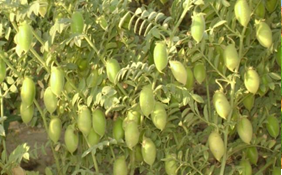 |
| Potential Yield: 20-22 q/ha | ||
| Duration: 105-115 days | ||
| Recommended Area: Central Zone of India | ||
| Ecology:Suitable for irrigated and timely sown condition | ||
| Special Characters:Kabuli type, creamy white seed colour with large seed size (34.0g/100 seed weight), moderately resistant to wilt | ||
| IPCK 2004-29 (Ujjawal, Kabuli type) | Year of Release: 2010 (CVRC) |  |
| Potential Yield: 20-22 q/ha | ||
| Duration: 105-115 days | ||
| Recommended Area:Central Zone of India | ||
| Ecology:Suitable for irrigated and timely sown condition | ||
| Special Characters:Kabuli type, creamy white seed colour with large seed size (35g/100-seed wt.), moderately resistant to fusarium wilt. | ||
| IPC 2006-77 (Desi type) | Year of Release: 2019 (CVRC) | 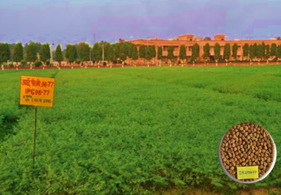 |
| Potential Yield: 20-25 q/ha | ||
| Duration:115-120 days | ||
| Recommended Area:Central Zone | ||
| Ecology:Suitable for irrigated and late sown condition | ||
| Special Characters:Resistance to wilt and moderate tolerant to DRR, stunt, collar rot, light brown seed with small seed size (16.5g/100 seed weight) and higher protein content (>24%). | ||
| IPC 2004-98 (Desi type) | Year of Release: 2020, SVRC (UP) | 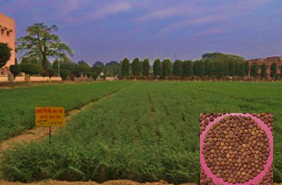 |
| Potential Yield: 18-20 q/ha | ||
| Duration:135-140 days | ||
| Recommended Area:Central and Bundelkhand region of Uttar Pradesh | ||
| Ecology:Suitable for irrigated and timely sown condition | ||
| Special Characters:Resistance to wilt, brown seed colour with large seed size (25.8g/100 seed wt.) | ||
| IPC 2004-01 (Desi type) | Year of Release: 2020, SVRC (UP) |  |
| Potential Yield: 18-20 q/ha | ||
| Duration:120-125 days | ||
| Recommended Area: Central and Bundelkhand region of Uttar Pradesh | ||
| Ecology:Suitable for irrigated and timely sown condition | ||
| Special Characters:Resistance to wilt, brown seed colour with medium seed size (20.2g/100 seed wt.) | ||
| IPC 2005-62 (Desi type) | Year of Release: 2020, SVRC (UP) | 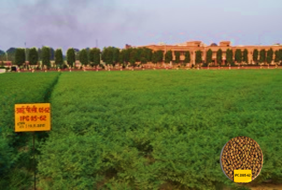 |
| Potential Yield: 18-20 q/ha | ||
| Duration:120-125 days | ||
| Recommended Area:Western and Bundelkhand regions of Uttar Pradesh | ||
| Ecology:Suitable for irrigated and late sown condition | ||
| Special Characters:Resistance to wilt, brown seed colour with small seed (15.2g /100 seed weight), higher protein content (>26%) | ||
| IPC 2011-112 (Keshav, Desi type) | Year of Release:2020, SVRC (UP) | 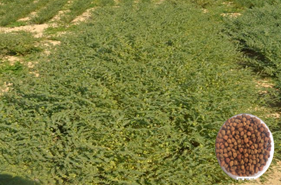 |
| Potential Yield: 20-22 q/ha | ||
| Duration:135-140 days | ||
| Recommended Area:Western regions of Uttar Pradesh | ||
| Ecology:Suitable for irrigated and timely sown condition | ||
| Special Characters:Resistance to wilt, brown seed colour with medium seed size (20.2g/100 seed wt.) | ||
| IPC 2007-28 (Atal, Desi type ) | Year of Release:2021, SVRC (UP) |  |
| Potential Yield: 20-22 q/ha | ||
| Duration:115-125 days | ||
| Recommended Area:Eastern region of Uttar Pradesh | ||
| Ecology:Suitable for irrigated and late sown condition | ||
| Special Characters:Highly resistant to wilt, tolerant to DRR, Collor rot diseases, brown and medium seed size (18.5g/100 seed wt.) | ||
| IPC 2010-134 (Shiva, Desi type) | Year of Release:2021, SVRC (UP) | 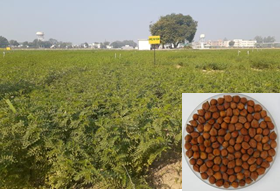 |
| Potential Yield: 22-24 q/ha | ||
| Duration:125-135 days | ||
| Recommended Area:Western and Bundelkhand regions of Uttar Pradesh | ||
| Ecology:Suitable for irrigated and timely sown condition | ||
| Special Characters:Highly resistant to wilt, moderately tolerant to DRR, brown and medium seed size (23.0g/100 seed weight) | ||
| IPCK 2013-163 (Madhav, Kabuli type) | Year of Release:2021 (CVRC) |  |
| Potential Yield: 22-24 q/ha | ||
| Duration:125-135 days | ||
| Recommended Area:North West Plain Zone of India | ||
| Ecology:Suitable for irrigated and timely sown condition | ||
| Special Characters:Seed creamy beige colour with large seed size (28.7g/100 seed weight) and moderately resistance to fusarium wilt, dry root rot and collar rot, stunt diseases. | ||
| IPCL 4-14 (Desi Type, MAS product) | Year of Release:2021 (CVRC) | 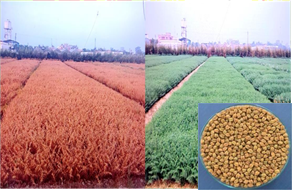 |
| Potential Yield: 18-20 q/ha | ||
| Duration:130-135 days | ||
| Recommended Area:North West Plain Zone of India | ||
| Ecology:Suitable for irrigated and timely sown condition | ||
| Special Characters:Drought tolerant MAS product. Seed light brown colour with small seed size (16.6g/100 seed weight) and resistance to fusarium wilt, collar rot, stunt diseases and moderately tolerant to dry root rot. |
Pigeonpea:
| Crop Name | Features | Image |
|---|---|---|
| IPA 203 (Prakash) | Year of Release: 2015 (CVRC) | 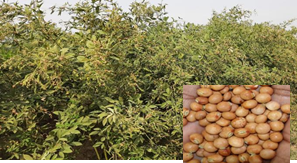 |
| Potential Yield: 25-28 q/ha | ||
| Duration:249-255 days | ||
| Recommended Area: North East Plain Zone | ||
| Special Characters:Resistant to fusarium wilt, light brown colour seed with medium size seed (12-14 g/100-seed) | ||
| IPA 206 (Ganga) | Year of Release: 2019, SVRC (UP) | 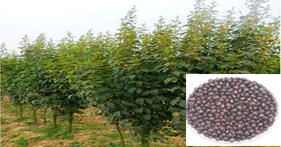 |
| Potential Yield: 25-26 q/ha | ||
| Duration: 245-250 days | ||
| Recommended Area: Uttar Pradesh | ||
| Special Characters:Resistant to wilt and SMD, purple seed colour with medium size seed (10- 11 g/100-seed wt.) | ||
| IPA 15-2 (Sharada) | Year of Release: 2020 (CVRC) | 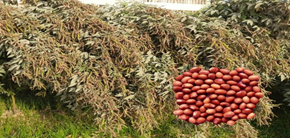 |
| Potential Yield: 28-33 q/ha | ||
| Duration: 240-255 days | ||
| Recommended Area:North East Plain Zone | ||
| Special Characters:Resistant to fusarium wilt and sterility mosaic, brown colour seed with medium size seed (10-12 g/100 seed) | ||
| IPH 15-03 (Hybrid) | Year of Release: 2020 (CVRC) |  |
| Potential Yield: 24-25 q/ha | ||
| Duration:150-155 days | ||
| Recommended Area:North West Plain Zone | ||
| Special Characters:Hybrid variety resistant to wilt, brown seed colour with medium seed size (8- 8.54 g /100 seed wt.) | ||
| IPH 9-05 (Hybrid) | Year of Release:2021 (CVRC) | 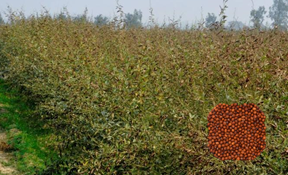 |
| Potential Yield: 22-23 q/ha | ||
| Duration:150-155 days | ||
| Recommended Area: North West Plain Zone | ||
| Special Characters:Hybrid variety tolerant to Phytophthora blight, sterility mosaic and moderately resistant to wilt, medium seed size (9- 9.6 g/100-seed) | ||
| IPAE 15-6 | Year of Release: 2021 (CVRC) | 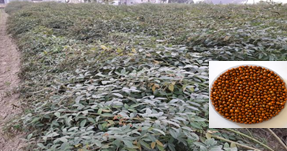 |
| Potential Yield: 21-25 q/ha | ||
| Duration:129-149 days | ||
| Recommended Area:Central zone | ||
| Special Characters:Tolerant to sterility mosaic, phytophthora blight and moderately resistant to wilt, medium brown seed size (9.5-10 g/100-seed) |
Mungbean:
| Crop Name | Features | Image |
|---|---|---|
| PDM 11 | Year of Release: 1987 (CVRC) | 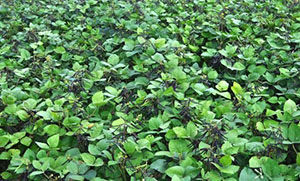 |
| Average Yield: 8-10 q/ha | ||
| Duration:75 days | ||
| Recommended Area: North East Plain Zone, Central Zone | ||
| Special Characters:Resistant to yellow mosaic disease | ||
| PDM 54 (Moti) | Year of Release: 1987 (CVRC) | 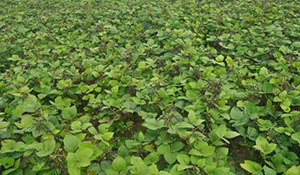 |
| Average Yield:8-10 q/ha | ||
| Duration: 65 days | ||
| Recommended Area: North West Plain Zone, North East Plain Zone | ||
| Special Characters:Early maturity, large seeds, multiple disease resistance | ||
| PDM 139 (Samrat) | Year of Release: 2001, SVRC (UP) | 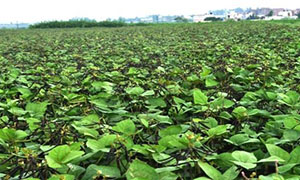 |
| Average Yield: 10-12 q/ha | ||
| Duration: 58-62 days | ||
| Recommended Area:Uttar Pradesh | ||
| Special Characters:Early maturity, MYMV resistance, shining green seed | ||
| IPM 99-125 (Meha) | Year of Release: 2004 (CVRC) | 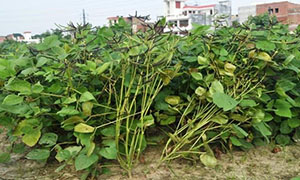 |
| Average Yield: 12-15 q/ha | ||
| Duration: 65-72 days | ||
| Recommended Area:North East Plain Zone | ||
| Special Characters:Early maturity, MYMV resistance | ||
| IPM 02-3 | Year of Release:2009 (CVRC) | 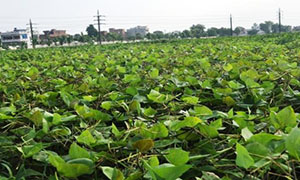 |
| Average Yield: 12-15 q/ha | ||
| Duration:65-70 days | ||
| Recommended Area: North West Plain Zone | ||
| Special Characters:Photo and thermo-insensitive with highly resistance to YMD | ||
| IPM 2-14 | Year of Release: 2011 (CVRC) |  |
| Average Yield:12-14 q/ha | ||
| Duration:62-65 days | ||
| Recommended Area:South Zone | ||
| Special Characters:Highly resistant YMD | ||
| IPM 205-7 (Virat) | Year of Release: 2016 (CVRC) | 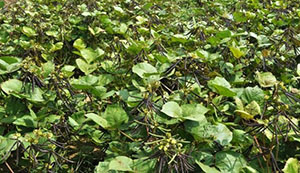 |
| Average Yield:13-15 q/ha | ||
| Duration:55 days | ||
| Recommended Area:Karnataka, TN, MP, Gujarat , Rajasthan, Maharashtra, UP | ||
| Special Characters:Highly resistant to YMD, PM and CLS | ||
| IPM 410-3 (Shikha) | Year of Release:2016 (CVRC) | 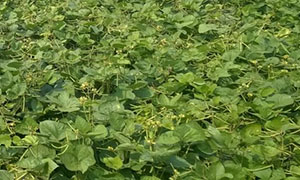 |
| Average Yield:13-16 q/ha | ||
| Duration:60-65 days | ||
| Recommended Area:North West Plain Zone, Central Zone | ||
| Special Characters:Highly resistant to YMD, PM, CLS | ||
| IPM 2014-9 (Varsha) | Year of Release: 2018, SVRC (UP) | 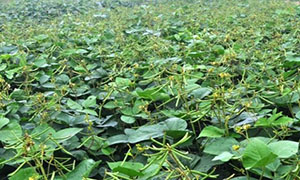 |
| Potential Yield: 10-12 q/ha | ||
| Duration:65-75 days | ||
| Recommended Area:Uttar Pradesh | ||
| Special Characters:Highly resistant to YMD, PM, mod resistant to CLS | ||
| IPM 302-2 (Kanika) | Year of Release: 2018, SVRC (UP) | 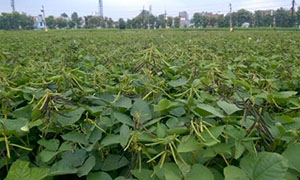 |
| Potential Yield: 10-12 q/ha | ||
| Duration:70-75 days | ||
| Recommended Area:Uttar Pradesh | ||
| Special Characters:Highly resistant to YMD, PM, resistant to leaf curl. | ||
| IPM 312-20 (Vasudha) | Year of Release: 2020, SVRC (UP) | 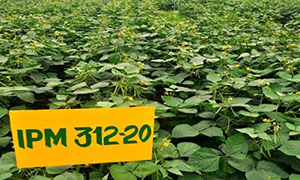 |
| Potential Yield: 12-14 q/ha | ||
| Duration:70-80 days | ||
| Recommended Area:Uttar Pradesh | ||
| Special Characters:Resistant to YMD, PM and cercospora leaf spot. | ||
| IPM 409-4 (Heera) | Year of Release: 2020, SVRC (UP) | 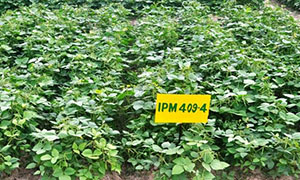 |
| Potential Yield: 11-12 q/ha | ||
| Duration:70-74 days | ||
| Recommended Area:Uttar Pradesh | ||
| Special Characters:Resistant to YMD, PM and CLS | ||
| IPM 512-1 (Soorya) | Year of Release: 2020 (CVRC) | 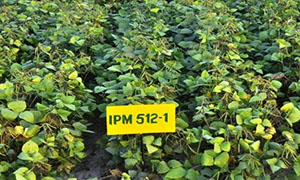 |
| Potential Yield: 14-16 q/ha | ||
| Duration:65-70 days | ||
| Recommended Area:North East Plain Zone | ||
| Special Characters:Highly resistant to YMD, CLS and anthracnose |
Urdbean:
| Crop Name | Features | Image |
|---|---|---|
| PDU 1 (Basant Bahar) | Year of Release: 1991 (CVRC) |  |
| Potential Yield: 9-10 q/ha | ||
| Duration:70-80 days | ||
| Recommended Area: North West Plain Zone, Central Zone | ||
| Special Characters:MYMV tolerant, good plant type | ||
| IPU 94-1 (Uttara) | Year of Release: 1999 (CVRC) | 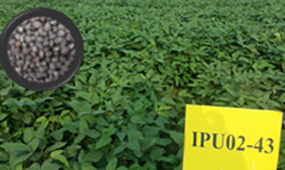 |
| Potential Yield:12-14 q/ha | ||
| Duration:80-85 days | ||
| Recommended Area: North West Plain Zone, North East Plain Zone | ||
| Special Characters:MYMV resistant, attractive plant type | ||
| IPU 02-43 | Year of Release: 2008 (CVRC) |  |
| Potential Yield:10-12 q/ha | ||
| Duration:70-72 days | ||
| Recommended Area:South Zone | ||
| Special Characters:MYMV and Powdery mildew resistant | IPU 11-02 | Year of Release:2019, SVRC (UP, MP) | 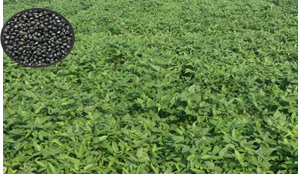 |
| Potential Yield: 10-12 q/ha | ||
| Duration:80-85 days | ||
| Recommended Area: Madhya Pradesh and Uttar Pradesh | ||
| Special Characters:Dull black colour with medium large seed (4.3g/100 seed wt.) and high protein content (26%), resistant to MYMV, ULCV, PM, anthracnose and Cercospora leaf spot | ||
| IPU 10-26 | Year of Release:2019, SVRC (MP) | 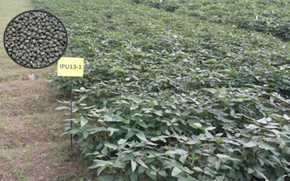 |
| Potential Yield: 10-12 q/ha | ||
| Duration:70-75 days | ||
| Recommended Area: Madhya Pradesh | ||
| Special Characters:Shining black seed colour, medium large seed (3.82g/100 seed wt.) with high protein content (25%), highly resistant to MYMV, Cercospora leaf spots and resistant to ULCV, stem necrosis, web blight, BLB, anthracnose, PM |
Lentil:
| Crop Name | Features | Image |
|---|---|---|
| DPL 15 (Priya) | Year of Release: 1995 (CVRC) | 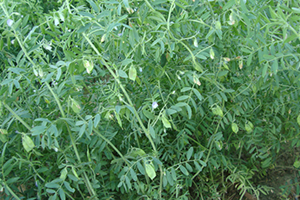 |
| Potential Yield: 15-16 q/ha | ||
| Duration:135-140 days | ||
| Recommended Area: North West Plain Zone | ||
| Special Characters:Resistant to rust and tolerance to wilt | ||
| DPL 62 (Sheri) | Year of Release: 1997 (CVRC) |  |
| Potential Yield:17-18 q/ha | ||
| Duration:130-135 days | ||
| Recommended Area: North West Plain Zone | ||
| Special Characters:Resistant to rust and tolerance to wilt with large seeds | ||
| IPL 81 (Noori) | Year of Release: 2000 (CVRC) | 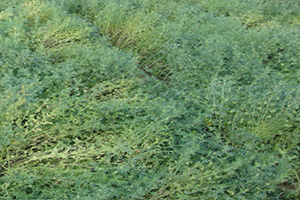 |
| Potential Yield:12-14 q/ha | ||
| Duration:110-115 days | ||
| Recommended Area:Central Zone | ||
| Special Characters:Tolerant to rust and wilt, medium size seeds | ||
| IPL 406 (Angoori | Year of Release: 2007 (CVRC) |  |
| Potential Yield:17-18 q/ha | ||
| Duration: 125-130 days | ||
| Recommended Area:North West Plain Zone | ||
| Special Characters:Tolerant to rust and wilt, extra-large seeds | ||
| IPL 316 | Year of Release:2013 (CVRC) |  |
| Potential Yield: 18-20 q/ha | ||
| Duration:102-112 days | ||
| Recommended Area:Central Zone | ||
| Special Characters:Resistance to wilt and rust. Seed brown with red cotyledons and large (3.1g/100 seed wt.) | ||
| IPL 526 | Year of Release:2015, SVRC (UP) |  |
| Potential Yield: 10-15 q/ha | ||
| Duration:105-112 days | ||
| Recommended Area: Uttar Pradesh | ||
| Special Characters:Tolerance to wilt and rust diseases, seed attractive with large size (3.0 g/100 seeds) and red cotyledons | ||
| IPL 220 (Biofortified variety) | Year of Release:2018 (CVRC) | 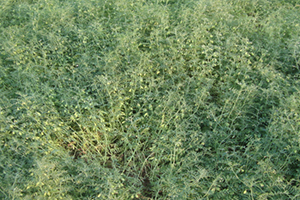 |
| Potential Yield: 15-20 q/ha | ||
| Duration:120-125 days | ||
| Recommended Area:North East Plain Zone | ||
| Special Characters:Resistance to rust, wilt and stemphylium blight, brown seed coat with orange cotyledon and small seeded (2.4g/100 seed wt), high Zn& Fe content | ||
| IPL 321 | Year of Release:2018, SVRC (UP) |  |
| Potential Yield:12-14 q/ha | ||
| Duration:125-135 days | ||
| Recommended Area:Uttar Pradesh | ||
| Special Characters:Resistant to wilt with large seeded | ||
| IPL 315 | Year of Release:2019, SVRC (UP) | 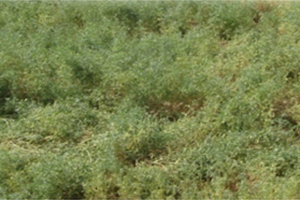 |
| Potential Yield: 15-20 q/ha | ||
| Duration:129-138 days | ||
| Recommended Area: Uttar Pradesh | ||
| Special Characters:Resistant to rust and tolerant to wilt. Seed brown colour with orange cotyledons and large size (2.9 g/100 seed-weight) | ||
| IPL 534 | Year of Release:2019, SVRC (MP) | 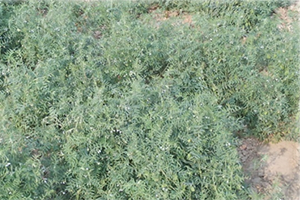 |
| Potential Yield: 14-16 q/ha | ||
| Duration:100-107 days | ||
| Recommended Area: Madhya Pradesh | ||
| Special Characters:Early maturing, Resistance to rust, wilt and stem phylium blight. Seed brown with red cotyledons and large size (3.2g/100 seed wt.) | ||
| IPL 225 | Year of Release:2020, SVRC (UP) |  |
| Potential Yield: 12-14 q/ha | ||
| Duration:105-133 days | ||
| Recommended Area: Uttar Pradesh | ||
| Special Characters:Highly resistance to rust and wilt diseases and small seeded (2.1 g/100 seeds), brown dotted seed coat and red cotyledons | ||
| IPL 329 | Year of Release:2020, SVRC (UP) | 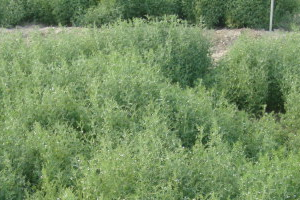 |
| Potential Yield:12-14 q/ha | ||
| Duration:115-134 days | ||
| Recommended Area: Uttar Pradesh | ||
| Special Characters:Resistance to rust and wilt diseases and large seeds (2.9g/100 seeds) with brown dotted seed coat and red cotyledons |
Fieldpea
| Crop Name | Features | Image |
|---|---|---|
| IPF 99-25 (Adarsh) | Year of Release:2000 (CVRC) |  |
| Potential Yield: 23-24 q/ha | ||
| Duration:110-115 days | ||
| Recommended Area: Central Zone | ||
| Special Characters:Tall, Powdery mildew resistance | ||
| IPFD 99-13 (Vikas) | Year of Release: 2005 (CVRC) |  |
| Potential Yield:22-25 q/ha | ||
| Duration:100-105 days | ||
| Recommended Area: Central Zone | ||
| Special Characters:Dwarf, Powdery mildew resistance | ||
| IPFD 01-10 (Prakash) | Year of Release: 2006 (CVRC) |  |
| Potential Yield:22-25 q/ha | ||
| Duration:110-115 days | ||
| Recommended Area:Central Zone, North Hill Zone | ||
| Special Characters:Large seeds, Powdery mildew resistance | ||
| IPF 05-19 (Aman) | Year of Release: 2009 (CVRC) |  |
| Potential Yield:22-25 q/ha | ||
| Duration: 120-130 days | ||
| Recommended Area:North West Plain Zone | ||
| Special Characters:Powdery mildew resistance, tolerant to rust | ||
| IPF 04-9 | Year of Release:2010, SVRC (UP) |  |
| Potential Yield: 18-20 q/ha | ||
| Duration:125-130 days | ||
| Recommended Area:Uttar Pradesh | ||
| Special Characters:Powdery mildew resistance, tolerant to rust | ||
| IPFD 10-12 (Green seed) | Year of Release:2014 (CVRC) |  |
| Potential Yield:21-22 q/ha | ||
| Duration:110-115 days | ||
| Recommended Area: Central Zone | ||
| Special Characters:Resistant to powdery mildew, Dwarf type, green seeds | ||
| IPFD 11-5 | Year of Release:2016 (CVRC) |  |
| Potential Yield: 22-23 q/ha | ||
| Duration:105-110 days | ||
| Recommended Area:Central Zone | ||
| Special Characters:Creamy white with round seeded, resistant to powdery mildew disease and moderately tolerant to pod borer | ||
| IPFD 6-3 | Year of Release:2016, SVRC (UP) |  |
| Potential Yield:19-20 q/ha | ||
| Duration:115-120 days | ||
| Recommended Area:Uttar Pradesh | ||
| Special Characters:Round seeded & creamy white seed coat colour with resistant to powdery mildew, tolerant to rust | ||
| IPFD 12-2 | Year of Release:2017 (CVRC) |  |
| Potential Yield: 22-25 q/ha | ||
| Duration:110 days | ||
| Recommended Area: Central Zone, | ||
| Special Characters:White and round seeded with resistant to powdery mildew disease, pod borer and moderately resistant to aphids and leaf miner | ||
| IPFD 14-2 | Year of Release:2018 (CVRC) |  |
| Potential Yield: 22-23 q/ha | ||
| Duration:105-110 days | ||
| Recommended Area:Central Zone | ||
| Special Characters:Tan colour mottled seed with resistant to powdery mildew | ||
| IPF 16-13 (Harit, Green seed) | Year of Release:2020 (CVRC) |  |
| Potential Yield:18-20 q/ha | ||
| Duration:115-120 days | ||
| Recommended Area: NEPZ | ||
| Special Characters:Round and green seeded variety with resistant to powdery mildew disease | ||
| IPFD 9-2 | Year of Release:2019, SVRC (UP) |  |
| Potential Yield:20-22 q/ha | ||
| Duration:125-130 days | ||
| Recommended Area: Uttar Pradesh | ||
| Special Characters:Round and creamish white colour seed variety with resistant to powdery mildew disease | ||
| IPFD 12-8 (Aakash) | Year of Release:2020, SVRC (UP) |  |
| Potential Yield:20-22 q/ha | ||
| Duration:120-130 days | ||
| Recommended Area: Uttar Pradesh | ||
| Special Characters:Resistant to powdery mildew and rust disease, dwarf and leafy type with medium creamish white round seed | ||
| IPFD 13-2 (Anant) | Year of Release:2020, SVRC (UP) |  |
| Potential Yield:20-22 q/ha | ||
| Duration:115-125 days | ||
| Recommended Area: Uttar Pradesh | ||
| Special Characters:Resistant to powdery, Downey mildew and rust disease, medium seed size with round, smooth and white seed colour |
Rajmash
| Crop Name | Features | Image |
|---|---|---|
| PDR 14 (Uday) | Year of Release: 1991 (CVRC) |  |
| Potential Yield: 20-22 q/ha | ||
| Duration:125-130 days | ||
| Recommended Area: North East Plain Zone | ||
| Special Characters:Tolerance to BCMV and variegated red seeds | ||
| IPR 96-4 (Amber) | Year of Release: 2002 (CVRC) |  |
| Potential Yield:20-24 q/ha | ||
| Duration:139-145 days | ||
| Recommended Area:North East Plain Zone | ||
| Special Characters:Resistant to BCMV & leaf crinckle | ||
| IPR 98-5 (Utkarsh) | Year of Release: 2005 (CVRC) |  |
| Potential Yield:24-25 q/ha | ||
| Duration:122-125 days | ||
| Recommended Area:North East Plain Zone | ||
| Special Characters:Tolerance to BCMV, Cold tolerance, attractive seed colour | ||
| IPR 98-3-1 (Arun) | Year of Release: 2007 |  |
| Potential Yield:24-25 q/ha | ||
| Duration: 120-125 days | ||
| Recommended Area:Central Zone | ||
| Special Characters:Tolerance to BCMV, attractive dark red medium seeds |

